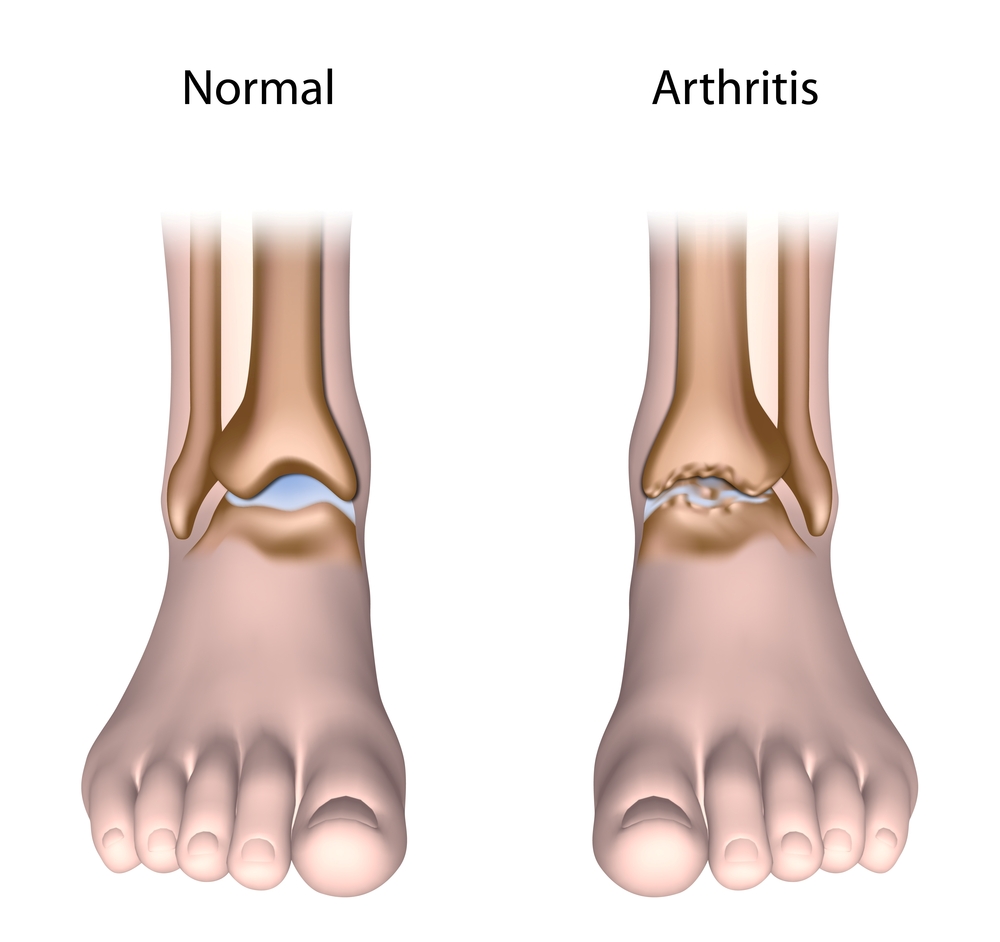
Ankle Osteoarthritis
Osteoarthritis is a relatively common health condition that generally affects older people. This condition is the result of the cartilage in joints deteriorating from a lifetime of wear and tear. Cartilage is the hard but flexible tissue that lines your joints and allows them to operate smoothly. If your cartilage erodes enough, your bones may grind against one another, causing pain, stiffness, inflammation and loss of mobility.
One of the most common sites for osteoarthritis is your legs which must endure a lifetime of pounding from walking and running. One joint in particular that is often targeted by osteoarthritis is the ankle because injuries so often happen to this vulnerable joint. There are a wide variety of treatments for ankle osteoarthritis that range from over-the-counter drugs to surgical procedures.
A Closer Look at the Ankle
Your ankle is a very complex joint with many components. In fact, there are really two joints in what we normally think of as the ankle; there is the true ankle joint and the subtalar joint. The three bones that form the true ankle joint are the shin bone (tibia), heel bone (talus) and thinner lower leg bone (fibula). The subtalar joint is composed of the talus bone and the calcaneus, bones that form the heel. These bones join in such a way as to allow up-and-down as well as side-to-side motion.
There are several ligaments and tendons in this joint that modulate movement in the ankle. The ends of the bones are covered with articular cartilage that provide lubrication and shock absorption. Major ligaments include the anterior tibiofibular ligament which connects the tibia to the fibula; the lateral collateral ligaments, which connect the fibula to the calcaneus and stabilizes the ankle; and the deltoid ligaments which connect the tibia to the talus and calcaneus.
It is easy to injure the ankle in the form of a sprain, strain or fracture because of the complexity of this joint. Although there is some lateral and vertical range of motion, this is, of course, limited by the joint’s architecture. Most ankle injuries occur when a sudden reversal in direction or burst of movement exceeds the natural tolerances of these joint components. Eventually, these injuries can contribute to joint deterioration.
The Most Common Form of Arthritis
The most common joint disorder in the U.S. is arthritis with 54.4 million Americans currently diagnosed with one form of arthritis. This number is expected to reach 78 million or 26 percent of the U.S. population by 2040, driven primarily by an aging population and current obesity trends. Arthritis is one of the leading causes of disability in the U.S., with 4 percent of all U.S. workers limited in their professional abilities because of their joint condition.
Out of the hundreds of forms of arthritis, osteoarthritis is the most common, affecting more than 32 million Americans. This condition is primarily related to deterioration of the joint lining, i.e. cartilage, due to age, overuse or prior injury. People with family members who suffer from osteoarthritis are more likely to develop it. Obesity is also a major risk factor because additional weight puts more strain on key joints like the hips and knees; obesity may also produce certain metabolic changes that can raise the risk of osteoarthritis.
Identifying Ankle Osteoarthritis
It may be easy to assume that osteoarthritis is the cause of ankle joint pain, but it may take some specialized diagnostic testing to confirm it and rule out other health conditions like rheumatoid arthritis, gout or cancer.
The first step in diagnosing ankle osteoarthritis is normally an X-ray of the joint. If the images show a loss of joint cartilage, thinning space between bones or bone spurs, it is likely to support a diagnosis of osteoarthritis.
This may be followed by arthrocentesis, a procedure in which joint fluid is removed using a needle. Simultaneously corticosteroids are injected to help relieve inflammation and pain. The joint fluid is analyzed for the presence of gout or infection.
If necessary, your physician may perform an arthroscopy in which a tiny camera is inserted into the joint. This provides a more detailed view of the structure of the joint including the thickness of the cartilage lining and the smoothness of the bone ends.
Treatments for Ankle Osteoarthritis
Ankle osteoarthritis is less common than osteoarthritis of the hip or knee, but it is common enough that treatment has become standardized. It is important that ankle osteoarthritis is detected early so that treatments can be used to slow the deterioration of the joint. This will help maintain your ability to use the joint for walking, climbing stairs and standing.
Although there are no cures for ankle osteoarthritis, your doctor may recommend one or more of the following treatments to manage the condition.
- Shoe inserts—in order to alleviate pressure on the ankle which can be quite painful, your doctor may suggest cushiony inserts. In some cases, you may also benefit from “rocker” shoes which have rounded soles and place less torque on the ankle while walking.
- Physical therapy—physical therapy may include exercises that increase the flexibility of soft tissue in the joint as well as the strength of nearby muscles. This can not only help retain mobility in the joint but also maintain remaining cartilage.
- Medications—many medications may be used to slow the progression of your ankle osteoarthritis as well as mitigate symptoms. You may take over-the-counter pain and inflammation relievers, opioid pain killers, or topical analgesics. There are new disease-modifying osteoarthritis drugs (DMOADs) that are currently in development and should reach the market soon.
- Injections—your physician may inject corticosteroids or hyaluronic acid into your ankle joint in an effort to reduce swelling and increase lubrication in the joint. Some doctors are also trying stem cell or platelet-rich plasma injections that purportedly help regrow cartilage.
- Surgery—if your symptoms don’t improve with more conservative therapies, then you may be a candidate for a surgical procedure like an ankle fusion, ankle replacement, or ankle debridement.
Article written by: Dr. Robert Moghim – CEO/Founder Colorado Pain Care
M.D. Disclaimer: The views expressed in this article are the personal views of Robert Moghim, M.D. and do not necessarily represent and are not intended to represent the views of the company or its employees. The information contained in this article does not constitute medical advice, nor does reading or accessing this information create a patient-provider relationship. Comments that you post will be shared with all visitors to this page. The comment feature is not governed by HIPAA and you should not post any of your private health information.



